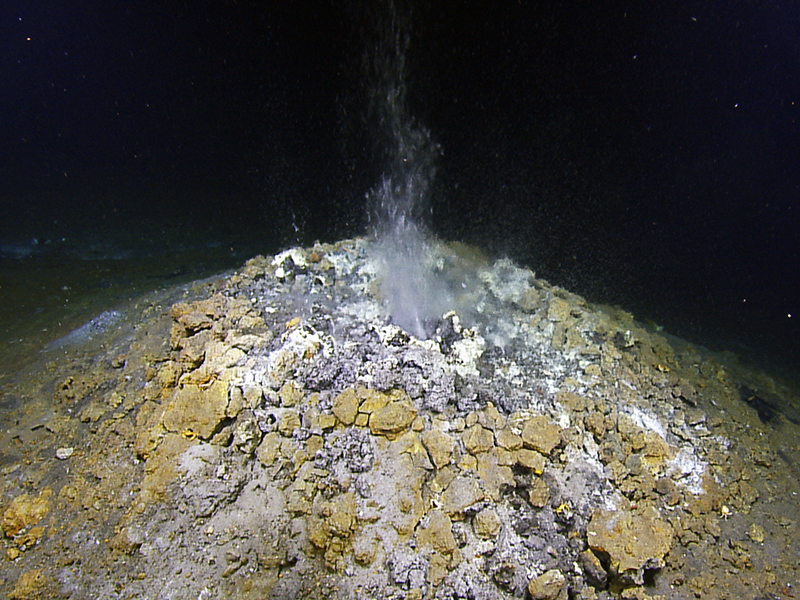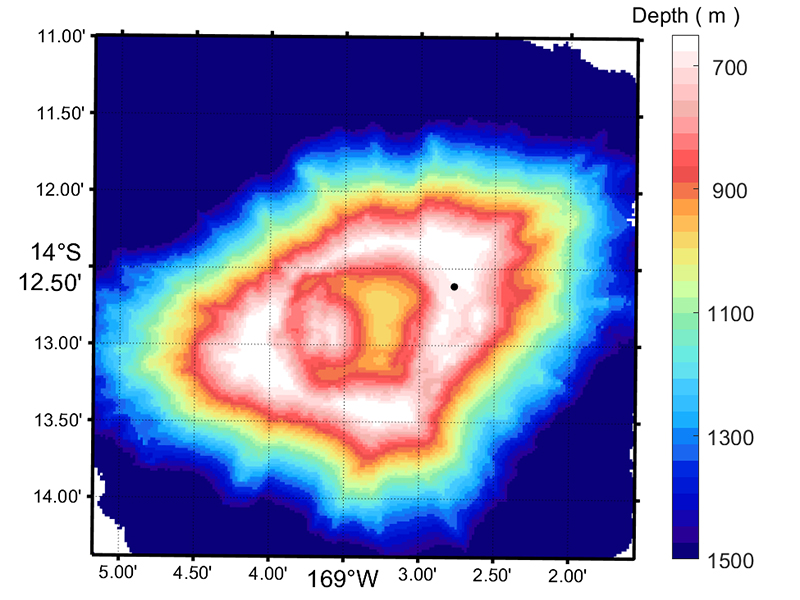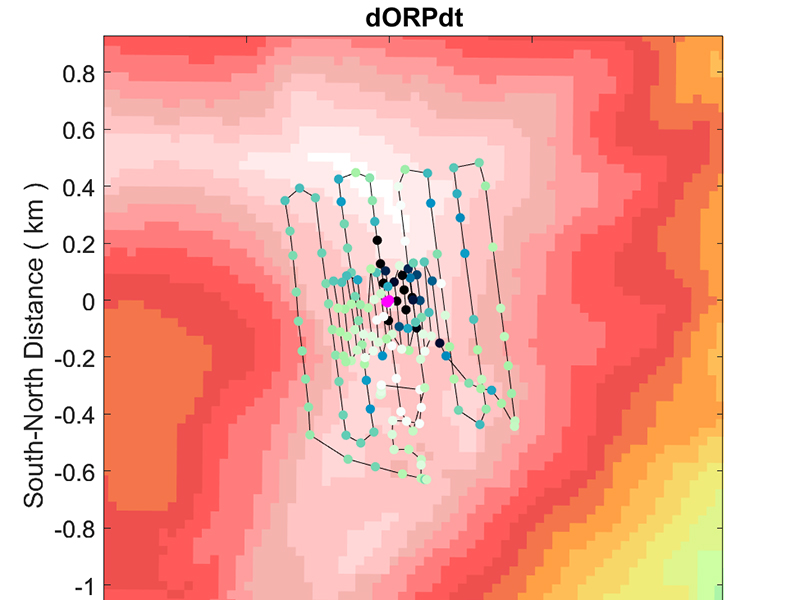Autonomous Localization of Seafloor Fluid Flow Sources
Dates
September 2024
Vessel
Exploration Vessel Nautilus
Location
National Marine Sanctuary of American Samoa
Primary goal
Develop a fully autonomous algorithm enabling autonomous underwater vehicles to trace biogeochemistry signatures in the water column that are indicative of hydrothermal vents and cold seeps using real-time data from onboard sensors.
Primary technology
Autonomous underwater vehicle Sentry, plume-tracing algorithm
Project Summary
To streamline the process of locating seafloor fluid flow sites such as hydrothermal vents and cold seeps, this research team is developing a fully autonomous algorithm to enable autonomous underwater vehicles (AUVs) to trace biogeochemistry signatures in the water column that are indicative of vents and seeps using real-time data recorded by onboard sensors, independent of human operators. In September 2024, during a NOAA Ocean Exploration Cooperative Institute expedition on Ocean Exploration Trust’s Exploration Vessel Nautilus, they tested a prototype of their plume-tracing algorithm during two AUV Sentry dives at Vailulu’u Seamount in National Marine Sanctuary of American Samoa.

The team selected Vailulu’u Seamount for this test because of its known hydrothermal activity. Early in the expedition, remotely operated vehicle Hercules revisited a hydrothermal vent on the eastern rim of the volcano’s crater, first discovered in 2019, and confirmed that it was still active.

To conduct the tests, Sentry, equipped with sensors for detecting anomalies in the water column associated with hydrothermal discharge, was deployed in the area of the vent site. While Sentry followed its pre-programmed route to conduct water column surveys, flying several tens of meters above the seafloor, sensor data were transmitted to shore in near real time for analysis by the plume-tracing algorithm. The algorithm processed the data collected over these initial large-scale surveys, identifying potential vent source locations and determining coordinates for the centers and boundaries of small-scale follow-up surveys to target the most probable source areas. These coordinates were then communicated back to the ship, where the AUV navigators redirected Sentry, and the exploration continued.
Deployment of autonomous underwater vehicle Sentry from Exploration Vessel Nautilus during the E Mamana Ou Gataifale II — American Samoa expedition. Video courtesy of Autonomous Localization of Seafloor Fluid Flow Sources. Download largest version (mp4, 16.7 GB)
Outcomes
Evaluation of the algorithm’s performance suggests it performed as anticipated. During both dives, the algorithm successfully determined coordinates for follow-up surveys of areas most likely to encompass hydrothermal vent sources. These coordinates aligned well with those the dive watchstanders, who have extensive experience in hydrothermal plume tracing, would have selected in a traditional human-guided mission. The testing also confirmed that sudden decreases in oxidation-reduction potential (ORP) were the most sensitive and reliable indicators of hydrothermal activity.
There was another important outcome that has implications for the future use of uncrewed marine systems (on Earth and beyond): This project demonstrated, for the first time, that it’s possible to transfer necessary data and contextual information from an AUV in the deep ocean all the way to a remote center ashore and for guidance to then be sent back to the AUV, all while the vehicle is still submerged and continuing operations.


Next Steps
The remainder of the project will focus on further developing the autonomous plume-tracing algorithm and integrating it into Sentry’s command and control system to achieve fully autonomous plume tracing.
The surveys conducted in September 2024 showed that parameters used as indicators of hydrothermal activity, such as ORP, can vary significantly with depth. Additionally, hydrothermal discharge expands and disperses as it rises from the seafloor. To address these variabilities, future testing will explore the use of multilevel surveys at different depths to improve the precision of hydrothermal source localization.
This project is anticipated to improve the efficiency of AUV-based exploration and enhance the ability of scientists to conduct other operations at the same time while at sea. Ultimately, it has the potential to improve our knowledge about seafloor vents and seeps and the marine life they support — in our ocean as well as those on other ocean worlds.
Education Content
Education Theme pages provide the best of what the NOAA Ocean Exploration website has to offer to support educators in the classroom related to this project. Each theme page includes expedition features, lessons, multimedia, career information, and associated past projects.
Additional resources are available through the Deep Ocean Education Project, a collaboration among NOAA Ocean Exploration, Ocean Exploration Trust, and Schmidt Ocean Institute.
Related Links
- What is the difference between cold seeps and hydrothermal vents?
- Autonomous Underwater Vehicles | Autonomous underwater vehicle Sentry
- Expedition: E Mamana Ou Gataifale II - American Samoa
- Operational Exploration in American Samoa: OECI Seminar Series
- Exploration Vessel Nautilus
- National Marine Sanctuary of American Samoa
Partners
- University of Washington Applied Physics Laboratory (Principal Investigator Guangyu Xu)
- Woods Hole Oceanographic Institution (Co-Principal Investigator Chris German)
- NASA Jet Propulsion Laboratory (Co-Principal Investigator Andrew Branch)
- NOAA Uncrewed Systems Operations Center
- NOAA Ocean Exploration Cooperative Institute
- Ocean Exploration Trust
Media Contacts
Emily Crum
Communications Specialist
NOAA Ocean Exploration
ocean-explore-comms@noaa.gov
Funding for this project was provided by NOAA Ocean Exploration via its Ocean Exploration Fiscal Year 2023 Funding Opportunity and by the NOAA Uncrewed Systems Operations Center. This project is representative of a long-term collaboration between NOAA Ocean Exploration and NASA to improve the efficiency of deep-ocean exploration, on Earth and beyond.
Published November 12, 2024


